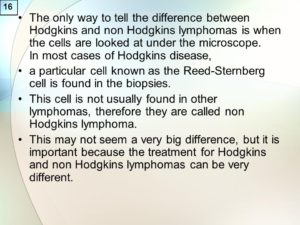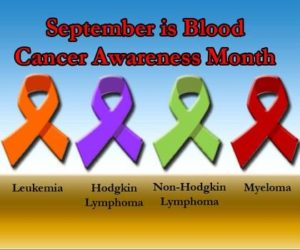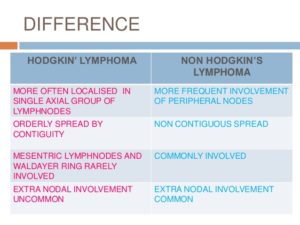
A particular cell known as the Reed-Sternberg cell is found in the biopsies. This cell is not usually found in other lymphomas, therefore they are called non Hodgkins lymphoma. This may not seem a very big difference, but it is important because the treatment for Hodgkins and non Hodgkins lymphomas can be very different.
Although the diseases may sound similar, there is a lot of difference between Hodgkin and non-Hodgkin lymphoma.
Both Hodgkin and non-Hodgkin lymphoma are malignancies of a family of white blood cells known as lymphocytes, which help the body fight off infections and other diseases.
Both Hodgkin’s lymphoma and non-Hodgkin’s lymphoma are lymphomas — a type of cancer that begins in a subset of white blood cells and these are called lymphocytes. Lymphocytes are an integral part of your immune system, which protects you from germs.
The main difference between Hodgkin’s lymphoma and non-Hodgkin’s lymphoma is in the specific lymphocyte each involves but also it includes:
| Hodgkin lymphoma | Non-Hodgkin lymphoma |
|---|---|
| Thirty-two percent of patients diagnosed with Hodgkin lymphoma are 20-34 years old. The median age of a patient diagnosed with the disease is 39. | Seventy-five percent of patients diagnosed with Hodgkin lymphoma 55 or older. The median age of a patient diagnosed with the disease is 66. |
| Hodgkin lymphoma is rare, accounting for about .5 percent of all new cancers diagnosed. An estimated 8,500 cases were diagnosed in 2016. | Non-Hodgkin lymphoma is the seventh most diagnosed cancer, accounting for an estimated 72,500 cases in 2016. |
| More than 86 percent of patients diagnosed with Hodgkin lymphoma survive five years or more. | About 70 percent of patients diagnosed with non-Hodgkin lymphoma survive five years or more. |
| There are six varieties of Hodgkin lymphoma. The most common forms are nodular sclerosis classical Hodgkin lymphoma and mixed cellularity classical Hodgkin lymphoma. They account for about 90 percent of all cases. | There are more than 61 types and subtypes of non-Hodgkin lymphoma. B-cell lymphomas account for 85 percent of all cases. Diffuse large B-cell lymphoma is the most common form on non-Hodgkin lymphoma. |
Sources: National Cancer Institute and Lymphoma Research Foundation 2016
Hodgkin lymphoma is marked by the presence of Reed-Sternberg cells, which are mature B cells that have become malignant, are unusually large, and carry more than one nucleus. The first sign of the disease is often the appearance of enlarged lymph nodes. Non-Hodgkin lymphoma, by contrast, can be derived from B cells or T cells and can arise in the lymph nodes as well as other organs. (B cells and T cells play different roles in the body’s immune response to disease.)
In 2017 by the Mayo Clinic it states both diseases are relatively rare, but non-Hodgkin lymphoma is more common in the United States, with more than 70,000 new cases diagnosed each year, compared to about 8,000 for Hodgkin lymphoma. The median age of patients with non-Hodgkin lymphoma is 60, but it occurs in all age groups. Hodgkin lymphoma most often occurs in people ages 15 to 24 and in people over 60. There are more than 60 distinct types of non-Hodgkin lymphoma, whereas Hodgkin lymphoma is a more homogeneous disease.
The two forms of lymphoma are marked by a painless swelling of the lymph nodes. Hodgkin lymphomas are more likely to arise in the upper portion of the body (the neck, underarms, or chest). Non-Hodgkin lymphoma can arise in lymph nodes throughout the body, but can also arise in normal organs. Patients with either type can have symptoms such as weight loss, fevers, and night sweats.
The diseases often follow different courses of progression. Hodgkin lymphoma tends to progress in an orderly fashion, moving from one group of lymph nodes to the next, and is often diagnosed before it reaches an advanced stage. Most patients with non-Hodgkin lymphoma are diagnosed at a more advanced stage.
Treatments for lymphoma vary depending on the type of disease, its aggressiveness, and location, along with the age and general health of the patient. As a general rule, however, Hodgkin lymphoma is considered one of the most treatable cancers, with more than 90 percent of patients surviving more than five years. Survival rates for patients with non-Hodgkin lymphoma tend to be lower, but for certain types of the disease, the survival rates are similar to those of patients with Hodgkin lymphoma.
A doctor can tell the difference between Hodgkin’s lymphoma and non-Hodgkin’s lymphoma by examining the cancer cells under a microscope. If in examining the cells, the doctor detects the presence of a specific type of abnormal cell called a Reed-Sternberg cell, the lymphoma is classified as Hodgkin’s. If the Reed-Sternberg cell is not present, the lymphoma is classified as non-Hodgkin’s.
Many subtypes of lymphoma exist, and your doctor will use laboratory tests to examine a sample of your lymphoma cells to determine your specific subtype. Expect to wait a few days to receive results from these specialized tests.
Your type of lymphoma helps your doctor determine your prognosis and your treatment options. The types of lymphoma have very different disease courses and treatment choices, so an accurate diagnosis is an integral part of getting the care you need.
How both Hodgkin’s and Non-Hodgkin’s Disease are diagnosed:
- Physical exam. Your doctor checks for swollen lymph nodes, including in your neck, underarm and groin, as well as for a swollen spleen or liver.
- Blood and urine tests. Blood and urine tests may help rule out an infection or other disease. A sample of your blood is examined in a lab to see if anything in your blood indicates the possibility of cancer (in both of these diseases particularly the WBCs).
- Imaging tests. Your doctor may recommend imaging tests to look for tumors in your body. Tests may include X-ray, CT, MRI and positron emission tomography (PET).
- Lymph node test. Your doctor may recommend a lymph node biopsy procedure to remove all or part of a lymph node for laboratory testing. Analyzing lymph node tissue in a lab may reveal whether you have non-Hodgkin’s lymphoma and, if so, which type. Your doctor may recommend a lymph node biopsy procedure to remove a lymph node for laboratory testing. He or she will diagnose classical Hodgkin’s lymphoma if abnormal cells called Reed-Sternberg cells are found within the lymph node.
- Bone marrow test. A bone marrow biopsy and aspiration procedure involves inserting a needle into your hipbone to remove a sample of bone marrow. The sample is analyzed to look for non-Hodgkin’s lymphoma cells to look for non-Hodgkin’s lymphoma cells or to look for non-Hodgkin’s lymphoma cells. This test is done on numerous types of cancer patients in helping to diagnose the cancer they have.
Treatments for both Hodgkin’s Lymphoma & Non-Hodgkin’s Lymphoma:
First the doctor needs to know what stage of cancer your in ranging from I to IV. This shows the doctor the following information to help the M.D. decide what treatment would be most effective to take.
- Stage I. The cancer is limited to one lymph node region or a group of nearby nodes or limited to a single organ.
- Stage II. In this stage, the cancer is in two lymph node regions, or the cancer has invaded one organ and the nearby lymph nodes as well. But the cancer is still limited to a section of the body either above or below the diaphragm.
- Stage III. When the cancer moves to lymph nodes both above and below the diaphragm, it’s considered stage III. Cancer may also be found in the lymph nodes above the diaphragm and in the spleen in non-Hodgkins and may also be in one portion of tissue or an organ near the lymph node groups or in the spleen in Hodgkins.
- Stage IV. This is the most advanced stage of non-Hodgkin’s and Hodgkin’s lymphoma. Cancer cells are in several portions of one or more organs and tissues.
- Stage III. When the cancer moves to lymph nodes both above and below the diaphragm, it’s considered stage III. Cancer may also be in one portion of tissue or an organ near the lymph node groups or in the spleen.
- Stage IV. This is the most advanced stage of Hodgkin’s lymphoma. Cancer cells are in several portions of one or more organs and tissues. Stage IV in both lymphomas affects not only the lymph nodes but also other parts of the body, such as the liver, lungs or bones.
Hodgkin Lymphoma Consultation
Your doctor will review your scans and discuss treatment options with you.
Which Hodgkin’s lymphoma treatments are right for you depends on the type and stage of your disease, your overall health, and your preferences. The goal of treatment is to destroy as many cancer cells as possible and bring the disease into remission.
Chemotherapy
Chemotherapy is a drug treatment that uses chemicals to kill lymphoma cells. Chemotherapy drugs travel through your bloodstream and can reach nearly all areas of your body.
Chemotherapy is often combined with radiation therapy in people with early-stage classical type Hodgkin’s lymphoma. Radiation therapy is typically done after chemotherapy. In advanced Hodgkin’s lymphoma, chemotherapy may be used alone or combined with radiation therapy.
Chemotherapy drugs can be taken in pill form or through a vein in your arm, or sometimes both methods of administration are used. Several combinations of chemotherapy drugs are used to treat Hodgkin’s lymphoma.
Side effects of chemotherapy depend on the drugs you’re given. Common side effects are nausea and hair loss. Serious long-term complications can occur, such as heart damage, lung damage, fertility problems and other cancers, such as leukemia.
Radiation therapy
Radiation therapy uses high-energy beams, such as X-rays and protons, to kill cancer cells. For classical Hodgkin’s lymphoma, radiation therapy is often used after chemotherapy. People with early-stage nodular lymphocyte-predominant Hodgkin’s lymphoma may undergo radiation therapy alone.
During radiation therapy, you lie on a table and a large machine moves around you, directing the energy beams to specific points on your body. Radiation can be aimed at affected lymph nodes and the nearby area of nodes where the disease might progress. The length of radiation treatment varies, depending on the stage of the disease. A typical treatment plan might have you going to the hospital or clinic five days a week for several weeks. At each visit, you undergo a 30-minute radiation treatment.
Radiation therapy can cause skin redness and hair loss at the site where the radiation is aimed. Many people experience fatigue during radiation therapy. More-serious risks include heart disease, stroke, thyroid problems, infertility and other cancers, such as breast or lung cancer.
Bone marrow transplant
Bone marrow transplant, also known as stem cell transplant, is a treatment to replace your diseased bone marrow with healthy stem cells that help you grow new bone marrow. A bone marrow transplant may be an option if Hodgkin’s lymphoma returns despite treatment.
During a bone marrow transplant, your own blood stem cells are removed, frozen and stored for later use. Next you receive high-dose chemotherapy and radiation therapy to destroy cancerous cells in your body. Finally your stem cells are thawed and injected into your body through your veins. The stem cells help build healthy bone marrow.
People who undergo bone marrow transplant may be at increased risk of infection.
Other drug therapy
Other drugs used to treat Hodgkin’s lymphoma include targeted drugs that focus on specific vulnerabilities in your cancer cells and immunotherapy that works to activate your own immune system to kill the lymphoma cells. If other treatments haven’t helped or if your Hodgkin’s lymphoma returns, your lymphoma cells may be analyzed in a laboratory to look for genetic mutations. Your doctor may recommend treatment with a drug that targets the particular mutations present in your lymphoma cells.
Targeted therapy is an active area of cancer research. New targeted therapy drugs are being studied in clinical trials.
Now look at Non-Hodgkin’s Lymphoma Treatment and look at the similarities of Hodkin’s Lymphoma Rx; both are WBC’s Blood Cancers:
If your non-Hodgkin’s lymphoma is aggressive or causes signs and symptoms, your doctor may recommend treatment. Options may include:
Chemotherapy
Chemotherapy is a drug treatment — given orally or by injection — that kills cancer cells. Chemotherapy drugs can be given alone, in combination with other chemotherapy drugs or combined with other treatments.
Side effects of chemotherapy depend on the drugs you’re given. Common side effects are nausea and hair loss. Serious long-term complications can occur, such as heart damage, lung damage, fertility problems and other cancers, such as leukemia.
Radiation therapy
Radiation therapy uses high-powered energy beams, such as X-rays and protons, to kill cancer cells. During radiation therapy, you’re positioned on a table and a large machine directs radiation at precise points on your body. Radiation therapy can be used alone or in combination with other cancer treatments.
During radiation therapy, you lie on a table and a large machine moves around you, directing the energy beams to specific points on your body. Radiation can be aimed at affected lymph nodes and the nearby area of nodes where the disease might progress. The length of radiation treatment varies, depending on the stage of the disease. A typical treatment plan might have you going to the hospital or clinic five days a week for several weeks, where you undergo a 30-minute radiation treatment at each visit.
Radiation therapy can cause skin redness and hair loss at the site where the radiation is aimed. Many people experience fatigue during radiation therapy. More-serious risks include heart disease, stroke, thyroid problems, infertility, and other cancers, such as breast or lung cancer.
Bone marrow transplant
Bone marrow transplant, also known as a stem cell transplant, involves using high doses of chemotherapy and radiation to suppress your bone marrow. Then healthy bone marrow stem cells from your body or from a donor are infused into your blood where they travel to your bones and rebuild your bone marrow.
People who undergo bone marrow transplant may be at increased risk of infection.
Other drug therapy
Biological therapy drugs help your body’s immune system fight cancer.
For example, one biological therapy called rituximab (Rituxan) is a type of monoclonal antibody that attaches to B cells and makes them more visible to the immune system, which can then attack. Rituximab lowers the number of B cells, including your healthy B cells, but your body produces new healthy B cells to replace these. The cancerous B cells are less likely to recur.
Also, a drug called ibrutinib (Imbruvica) has been approved by the Food and Drug Administration (FDA) for some people undergoing treatment for non-Hodgkin’s lymphoma.
Radioimmunotherapy drugs are made of monoclonal antibodies that carry radioactive isotopes. This allows the antibody to attach to cancer cells and deliver radiation directly to the cells. An example of a radioimmunotherapy drug used to treat non-Hodgkin’s lymphoma is ibritumomab tiuxetan (Zevalin).
Clinical trials
Clinical research studies (clinical trials) may be an option for people whose disease has not been controlled by other treatment options. Ask your doctor about possible clinical trials for your type of non-Hodgkin’s lymphoma.

